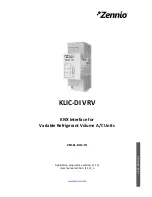
ENGINEERING MANUAL OF AUTOMATIC CONTROL
CONTROL FUNDAMENTALS
19
Because the heat is supplied to the sensor only, the heat
anticipation feature lowers the control point as the heat requirement
increases. The lowered control point, called “droop”, maintains a
lower temperature at design conditions and is discussed more
thoroughly in the following paragraphs. Energizing the heater
during thermostat off periods accomplishes anticipating action in
cooling thermostats. In either case, the percentage on-time varies
in proportion to the system load.
TIME PROPORTIONING
Time proportioning control provides more effective two-
position control than heat anticipation control and is available
with some electromechanical thermostats and in electronic and
microprocessor-based controllers. Heat is introduced into the
space using on/off cycles based on the actual heat load on the
building and programmable time cycle settings. This method
reduces large temperature swings caused by a large total lag
and achieves a more even flow of heat.
In electromechanical thermostats, the cycle rate is adjustable
by adjusting the heater. In electronic and digital systems, the
total cycle time and the minimum on and off times of the
controller are programmable. The total cycle time setting is
determined primarily by the lag of the system under control. If
the total cycle time setting is changed (e.g., from 10 minutes to
20 minutes), the resulting on/off times change accordingly (e.g.,
from 7.5 minutes on/2.5 minutes off to 15 minutes on/5 minutes
off), but their ratio stays the same for a given load.
The cycle time in Figure 24 is set at ten minutes. At a 50
percent load condition, the controller, operating at setpoint,
produces a 5 minute on/5 minute off cycle. At a 75 percent
load condition, the on time increases to 7.5 minutes, the off
time decreases to 2.5 minutes, and the opposite cycle ratio
occurs at 25 percent load. All load conditions maintain the preset
10-minute total cycle.
10
7.5
5
2.5
0
SELECTED
CYCLE TIME
(MINUTES)
100
75
50
25
0
LOAD (%)
ON
OFF
C2090
Fig. 24. Time Proportioning Control.
Because the controller responds to average temperature or
humidity, it does not wait for a cyclic change in the controlled
variable before signaling corrective action. Thus control system
lags have no significant effect.
Droop in heating control is a lowering of the control point as
the load on the system increases. In cooling control, droop is a
raising of the control point. In digital control systems, droop is
adjustable and can be set as low as one degree or even less.
Figure 25 shows the relationship of droop to load.
Fig. 25. Relationship between Control Point,
Droop, and Load (Heating Control).
Time proportioning control of two-position loads is
recommended for applications such as single-zone systems that
require two-position control of heating and/or cooling (e.g., a
gas-fired rooftop unit with direct-expansion cooling). Time
proportioning control is also recommended for electric heat
control, particularly for baseboard electric heat. With time
proportioning control, care must be used to avoid cycling the
controlled equipment more frequently than recommended by
the equipment manufacturer.
STEP CONTROL
Step controllers operate switches or relays in sequence to
enable or disable multiple outputs, or stages, of two-position
devices such as electric heaters or reciprocating refrigeration
compressors. Step control uses an analog signal to attempt to
obtain an analog output from equipment that is typically either
on or off. Figures 26 and 27 show that the stages may be
arranged to operate with or without overlap of the operating
(on/off) differentials. In either case, the typical two-position
differentials still exist but the total output is proportioned.
Fig. 26. Electric Heat Stages.
22.5
22
21.5
0
0.1
1
DROOP (
°
C)
CONTROL POINT (
°
C)
DESIGN
TEMPERATURE
OUTDOOR AIR
TEMPERATURE
0%
100%
LOAD
C3974
NO LOAD
TEMPERATURE
23
ON
OFF
ON
OFF
ON
OFF
ON
OFF
ON
OFF
5
4
3
2
1
DIFFERENTIAL
THROTTLING RANGE
22
SPACE TEMPERATURE (
°
C)
100%
0%
LOAD
C3981
STAGES
Summary of Contents for AUTOMATIC CONTROL SI Edition
Page 1: ...AUTOMATIC CONTROL for ENGINEERING MANUAL of COMMERCIAL BUILDINGS SI Edition ...
Page 4: ...ENGINEERING MANUAL OF AUTOMATIC CONTROL iv ...
Page 6: ...ENGINEERING MANUAL OF AUTOMATIC CONTROL vi ...
Page 46: ...ENGINEERING MANUAL OF AUTOMATIC CONTROL CONTROL FUNDAMENTALS 36 ...
Page 66: ...ENGINEERING MANUAL OF AUTOMATIC CONTROL PSYCHROMETRIC CHART FUNDAMENTALS 56 ...
Page 128: ...ENGINEERING MANUAL OF AUTOMATIC CONTROL ELECTRIC CONTROL FUNDAMENTALS 118 ...
Page 158: ...MICROPROCESSOR BASED DDC FUNDAMENTALS 148 ENGINEERING MANUAL OF AUTOMATIC CONTROL ...
Page 208: ...ENGINEERING MANUAL OF AUTOMATIC CONTROL BUILDING MANAGEMENT SYSTEM FUNDAMENTALS 198 ...
Page 493: ...INDEX ENGINEERING MANUAL OF AUTOMATIC CONTROL 483 INDEX ...
Page 506: ...ENGINEERING MANUAL OF AUTOMATIC CONTROL INDEX 496 NOTES ...
Page 507: ...INDEX ENGINEERING MANUAL OF AUTOMATIC CONTROL 497 NOTES ...
Page 508: ...ENGINEERING MANUAL OF AUTOMATIC CONTROL INDEX 498 NOTES ...
Page 509: ...INDEX ENGINEERING MANUAL OF AUTOMATIC CONTROL 499 NOTES ...
Page 510: ...ENGINEERING MANUAL OF AUTOMATIC CONTROL INDEX 500 NOTES ...
Page 511: ...INDEX ENGINEERING MANUAL OF AUTOMATIC CONTROL 501 NOTES ...
Page 512: ...ENGINEERING MANUAL OF AUTOMATIC CONTROL INDEX 502 NOTES ...
















































